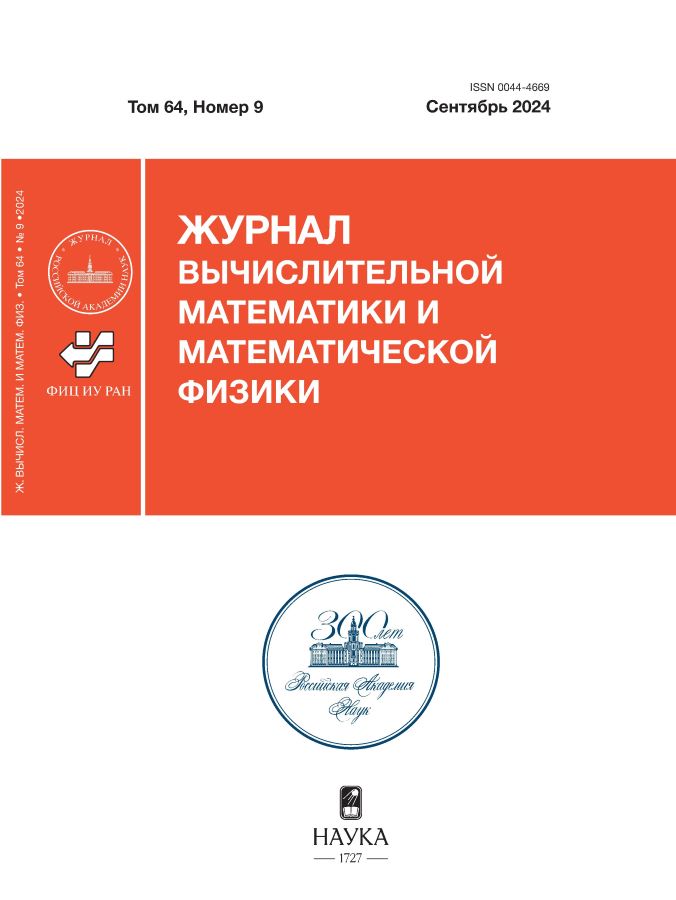NUMERICAL CALCULATION OF THE EFFECT OF THE METHANE MIGRATION PROCESS ON THE RESULTS OF SEISMIC EXPLORATION IN PERMAFROST ZONES
- 作者: Guseva E.K1, Golubev V.I1, Petrov I.B1
-
隶属关系:
- MIPT (National Research University)
- 期: 卷 64, 编号 9 (2024)
- 页面: 1708-1717
- 栏目: Mathematical physics
- URL: https://freezetech.ru/0044-4669/article/view/665199
- DOI: https://doi.org/10.31857/S0044466924090119
- EDN: https://elibrary.ru/WJPVOQ
- ID: 665199
如何引用文章
详细
For a long time, intense methane emissions into the atmosphere from the subsurface of permafrost have been observed in the shelf and coastal zones of the Arctic region. Due to the potential danger of this phenomenon to the environment and infrastructure, there is a need for periodic monitoring of gas pockets, including through ground-based seismic exploration. This paper contains the results of a study of this process using numerical modeling. A model of layered frozen sandy soil with curviliinear boundaries between the sheets is constructed, reflecting the main specifics of the region. The process of gas migration in vertical and horizontal directions is reconstructed by increasing the number of methane reservoirs. The defining system of hyperbolic equations of the linear theory of elasticity is used. The problem is solved by the grid-characteristic method in a two-dimensional formulation on a rectangular grid, in each cell of which the elastic characteristics of the layers are set. The resulting wave structures are studied in detail on the obtained synthetic wave patterns and seismograms, which make it possible to determine the direction of gas propagation. The results obtained can be used to interpret similar field experiments.
作者简介
E. Guseva
MIPT (National Research University)
Email: guseva.ek@phystech.edu
Dolgoprudny, Russia
V. Golubev
MIPT (National Research University)
Email: golubev.vi@mipt.ru
Dolgoprudny, Russia
I. Petrov
MIPT (National Research University)
Email: petrov@mipt.ru
Dolgoprudny, Russia
参考
- Li L. Special issue on numerical modeling in civil and mining geotechnical engineering // Processes. 2022. V. 10. № 8. 1571.
- Bath M. Introduction to seismology. V. 27. Birkhauser, 2013.
- Romanovsky V.E., Drozdov D.S., Oberman N.G., Malkova G.V., Kholodov A.L., Marchenko S.S., Moskalenko N.G., Sergeev D.O., Ukraintseva N.G., Abramov A.A., Gilichinsky D.A., Vasiliev A.A. Thermal state of permafrost in Russia // Permafrost Periglac. 2010. V 21. P. 136—155.
- Bogoyavlensky V.I., Kishankov A., Yanchevskaya A., Bogoyavlensky I.V. Forecast of gas hydrates distribution zones in the Arctic Ocean and adjacent offshore areas // Geosciences. 2018. V. 8. № 12. P. 453.
- Anisimov O., Zimov S. Thawing permafrost and methane emission in Siberia: Synthesis of observations, reanalysis, and predictive modeling // Ambio. 2021. V 50. P. 2050—2059.
- Streletskiy D.A., Clemens S., Lanckman J.-P., Shiklomanov N.I. The costs of Arctic infrastructure damages due to permafrost degradation // Environmental Res. Lett. 2023. V. 18. № 1. 015006.
- Bogoyavlensky V.I., Bogoyavlensky I.V., Nikonov R.A., Kargina T.N., Chuvilin E., Bukhanov B., Umnikov A. New catastrophic gas blowout and giant crater on the Yamal Peninsula in 2020: Results of the expedition and data processing // Geosciences. 2021. V. 11. № 2. P. 71.
- Богоявленский В.И., Богоявленский И.В., Никонов Р.А., Каргина Т.Н. Мониторинг развития Мордыяхского объекта взрыва газа на Ямале на основе данных дистанционного зондирования Земли // Арктика: экология и экономика. 2022. Т. 12. № 4. С. 513—523.
- Glikson A. The methane time bomb // Energy Procedía. 2018. V 146. P. 23—29.
- Favorskaya A.V., Petrov I.B. Wave responses from oil reservoirs in the Arctic shelf zone // Dokl. Earth Sc. 2016. V. 466. P 214-217.
- Favorskaya A.V., Petrov I.B. Grid-Characteristic Method // In: Favorskaya, A., Petrov, I. (eds) Innovations in Wave Processes Modelling and Decision Making. Smart Innovation, Systems and Technologies. 2018. V. 90. P. 117-160.
- Petrov I.B., Kozhemyachenko A.A. Favorskaya A.V. Simulation of Vibrations of Railway Structures by the GridCharacteristic Method // Dokl. Phys. 2023. V. 68. P. 30-34.
- Golubev V.I., Nikitin I.S., Beklemysheva K.A. Model of fractured medium and nondestructive control of composite materials // Chinese J. Aeronautics. 2023. V. 37. № 2. P. 93-99.
- Новацкий В. Теория упругости. М.: Мир, 1975.
- Stognii P.V., Petrov I.B., Khokhlov N.I. Numerical modelling of the reflected waves from gas cavities and methane bombs in the heterogeneous media of the Northern regions // IOP Conf. Ser.: Materials Science and Engineering. 2020. V. 927. № 1. 012006.
- Stognii P.V., Khokhlov N.I., Petrov I.B., Favorskaya A.V. The comparison of two approaches to modeling the seismic waves spread in the heterogeneous 2D medium with gas cavities // In: Favorskaya, M.N., Favorskaya, A.V., Petrov, I.B., Jain, L.C. (eds) Smart Modelling For Engineering Systems. Smart Innovation, Systems and Technologies. 2021. V. 214 P. 101-114.
- Stognii P.V., Khokhlov N.I., Petrov I.B. Numerical modeling of wave processes in multilayered media with gascontaining layers: comparison of 2D and 3D models // Dokl. Math. 2019. V. 100. P. 586-588.
- Rusanov V.V. Difference schemes of the third order of accuracy for the forward calculation of discontinuous solutions // Doklady Akademii Nauk. 1968. V. 180. P. 1303-1305.
- Guseva E.K., Golubev V.I., Petrov I.B. Linear quasi-monotone and hybrid grid-characteristic schemes for the numerical solution of linear acoustic problems // Numer. Analys. Appl. 2023. V. 16. P. 112-122.
- Трифонов Б.А., Милановский С.Ю., Несынов В.В. Оценка сейсмических воздействий в условиях деградации мерзлоты // Вестник КРАУНЦ. Сер.: Науки о Земле. 2022. Т. 56. № 4. C. 59-74.
- Fatyanov A.G. A wave method of suppressing multiple waves for any complex subsurface geometry // Numer. Analys. Appl. 2012. V. 5. P. 187-190.
- Nkemzi D. Anew formula for the velocity of Rayleigh waves // Wave Motion. 1997. V. 6. № 2. P. 199-205.
补充文件









